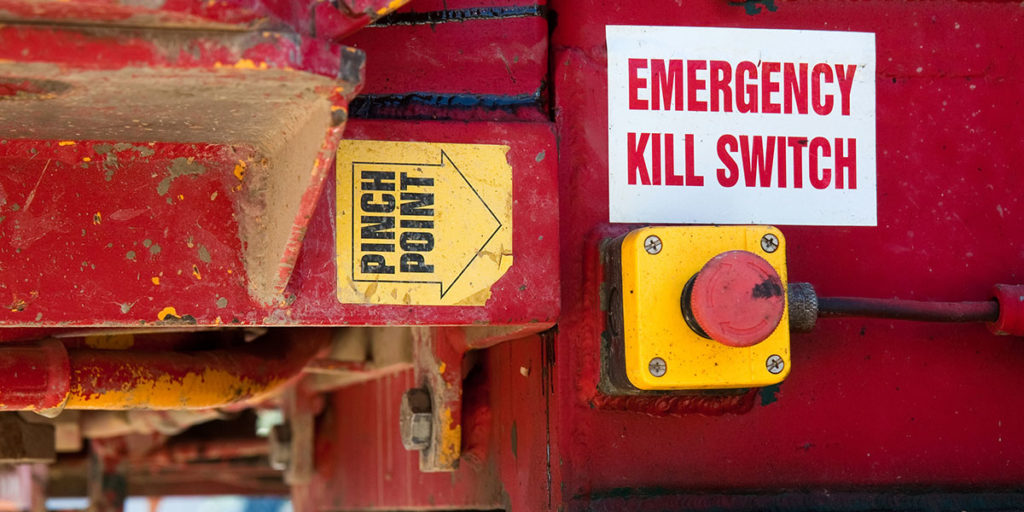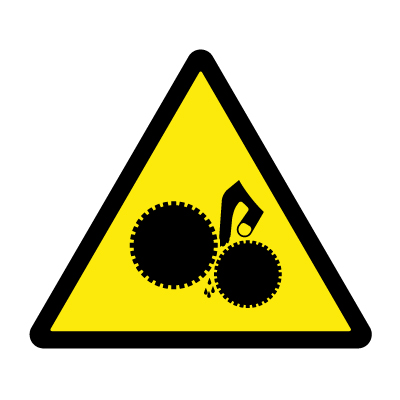Pinch Points
Posted: Oct. 22, 2019 • By Kevine Kohler

We check off “pinch points” all the time on our hazard inspections
Our treatment of this common checklist item, and its benign sounding name, may not do justice to the serious nature of “pinch point” hazards.
There are 500,000 hand injuries a year according to Canada Employment and the hand is the body part most frequently injured on the job according to Statistics Canada. Hands and tools held in hands are often the first point of accidental contact with machinery and moving parts, and the consequences of any body part getting drawn in or “pinched” can be serious or even fatal.
A “pinch” doesn’t sound all that bad

The Ontario Ministry of Labour (MOL) defines a pinch point as:
A point at which it is possible for a part of the body to be caught between moving parts and/or moving and stationary parts of equipment.
Any moving object has the potential to create a pinch point.
The following pinch point fatality, reported in the Daily Commercial News (March 26, 2018), illustrates just how serious these incidents can be:
While removing ice buildup on a pulley on a conveyor, which was moving, a metal bar being used by the worker was caught by the pinch point formed between the conveyor and the steel drum of the pulley. As the conveyor moved, the bar was pulled in and the worker holding the bar was pulled in with it, suffering fatal head injuries as a result.
The MOL investigation determined… (that no) precautions (had) been taken to prevent the worker from coming into contact with the conveyor’s moving parts.
It can be difficult to fully appreciate the power of moving objects and how quickly we can be pinched or drawn in.
We don’t have conveyors here, so we don’t worry about pinch points

Pinch points can occur anywhere that a part of the body (or clothing) can get caught between two objects. Pinch points can impact any area of the body.
Pinch points can include:
- Shear points: points where surfaces move close enough together to cut
- Nip points: points where rotating machinery moves together in a plane or point such as belt drive pulleys.
- Crush points: points where any two objects move together, one of which can be stationary
- Pull-in points: points where workers can be pulled into machinery along with other material, such as augers, crushers or feeders.
Best Practices – Controlling the Hazards
Pinch points must be safeguarded to control the hazard. Be aware of the “danger zone” where you are exposed to a pinch point hazard. A list of pinch point hazard controls from most effective to least effective includes:
- Elimination/Substitution: Eliminate the pinch point entirely by using a different process or equipment.
- Engineering Controls: Install stops, guards, barriers or sensing devices. De-energize and lock-out equipment.
- Administrative Procedures: Place warning signs, establish restricted areas, or install warning lights and horns. Establish written safe work practices and make sure that they are followed.
- PPE: Should only be used along with other more effective controls.
The OH&S legislation for your jurisdiction will include the specific requirements that you have for protecting workers from pinch points. These requirements may refer you to a standards organization (ANSI, CSA, etc.) or cite specific guarding requirements and approach distances. Both employers and employees have a legislated duty not to modify, remove, defeat, tamper or interfere with any guarding placed upon machinery by the manufacturer or employer.
It is your responsibility to ensure that safeguards are effective, approved and reflect current best practices.
Don’t get “caught” by a pinch point!
Related Articles

Drug and Alcohol Program Review
Our drug and alcohol program hasn’t changed A drug and alcohol program consists of a policy statement from senior management […]
Read Article
Confined Spaces
Confined spaces can be lethal A tragic example of confined space hazards is the Sullivan Mine incident where four people […]
Read Article